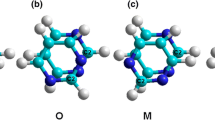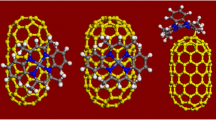Abstract
Functionalization is an important method to change electrical and thermodynamic properties of carbon nanotubes. In this study, the effect of functionalization of a single-walled carbon nanotube (SWCNT) was investigated with the aid of density functional theory. For this case, a (5, 0) zigzag SWCNT model containing 60 C atoms with 10 hydrogen atoms added to the dangling bonds of the perimeter carbons was used. To model hydroxyl CNT two terminal H atoms were replaced by two –OH groups. All the functionalized CNTs are thermodynamically more stable and have higher dipole moment with respect to the pristine CNT. Depending on the positions of hydroxyl groups on CNT five isomers of C60H8(OH)2 were obtained. The structure of these five isomers and molecular properties such as the HOMO–LUMO gaps, the dipole moments, and the density of state were calculated. Our results indicate that the HOMO–LUMO gap strongly depends on the placement of the hydroxyl groups on the nanotubes. The isomers were hydroxyl groups locate on the anti-position show the highest distortions in the structure of the CNT.
Similar content being viewed by others
References
S. Iijima, Nature 354, 56 (1991).
A. Minett, F. Schüth, S. W. Sing, J. Weitkapmp, K. Atkinson, and S. Roth, in Handbook of Porous Solids (Wiley-VCH, Weinheim, 2002).
Z. Yao, H. W. C. Postma, L. Balents, and C. Dekker, Nature 402, 273 (1999).
O. Zhou, H. Shimoda, B. Gao, S. Oh, L. Fleming, and G. Yue, Acc. Chem. Res. 35, 1045 (2002).
R. H. Baughman, C. Cui, A. A. Zakhidov, Z. Iqbal, J. N. Barisci, G. M. Spinks, G. G Wallace, A. Mazzoldi, D. de Rossi, A. G. Rinzler, O. Jaschinski, S. Roth, and M. Kertesz, Science 284, 1340 (1999).
N. Ferrer-Anglada, V. Gomis, Z. El-Hachemi, U. D. Weglikovska, M. Kaempgen, and S. Roth, Phys. Status Solidi 203, 1082 (2006).
Z. Chen, J. Appenzeller, Y. M. Lin, et al., Science 311, 1735 (2006).
D. A. Britz and A. N. Khlobystov, Chem. Soc. Rev. 35, 637 (2006).
Y. Sakakibara, A. G. Rozhin, H. Kataura, Y. Achiba, and M. Tokumoto, Jpn. J. Appl. Phys. 44, 1621 (2005).
M. E. Kose, B. A. Harruff, Y. Lin, L. M. Veca, F. Lu, and Y. P. Sun, J. Phys. Chem. B 110, 14032 (2006).
P. Serp, M. Corrias, and P. Kalck, Appl. Catal. A 253, 337 (2003).
M. V. Veloso, A. G. S. Filho, J. M. Filho, S. B. Fagan, and R. Mota, Chem. Phys. Lett. 430, 71 (2006).
T. Kar, B. Adkim, X. Duan, and R. Pachter, ChemPhysLett. 423, 126 (2006).
C. G. Salzmann, S. A. Llewellyn, G. Tobias, M. H. Y. Ward, Y. Huh, and M. L. H. Green, Adv. Mater. 19, 883 (2007).
J. Zhao, J. P. Lu, J. Han, and C. K. Yang, Appl. Phys. Lett. 82, 3746 (2003).
A. D. Becke, J. Chem. Phys. 98, 5648 (1993).
M. J. Frisch et al., Gaussian 03, Revision E.01 (Gaussian Inc., Wallingford, CT, 2004).
Gaussview 03 (Gaussian Inc., Wallingford, CT, 2003).
Author information
Authors and Affiliations
Corresponding author
Additional information
The article is published in the original.
Rights and permissions
About this article
Cite this article
Mostaanzadeh, H., Abbasi, A. & Honarmand, E. DFT Theoretical Calculation of the Site Selectivity of Dihydroxylated (5, 0) Zigzag Carbon Nanotube. Russ. J. Phys. Chem. 91, 2636–2642 (2017). https://doi.org/10.1134/S0036024417130155
Received:
Published:
Issue Date:
DOI: https://doi.org/10.1134/S0036024417130155




